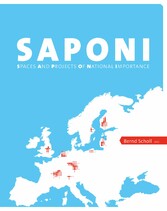Suchen und Finden
Service
SAPONI - Spaces and Projects of National Importance
Bernd Scholl
Verlag vdf Hochschulverlag AG, 2011
ISBN 9783728134615 , 132 Seiten
Format PDF
Kopierschutz Wasserzeichen
Geräte
Impressum
4
Index
5
Summary
9
Preface
13
1 Introduction
17
1.1 Point of departure
18
1.2 Some examples of SAPONI projects
18
2 Core of spaces and projects of national importance
21
2.1 Key questions on SAPONIs
22
2.1.1 Why
22
2.1.2 What
22
2.1.3 Who
23
2.1.4 How
25
2.2 Key features of SAPONIs
26
3 Learning from selected case studies
29
3.1 Cross-border (EU) projects
30
3.1.1 EU Strategy and the VASAB Perspective on the Baltic Sea Region | Ole Damsgaard
30
3.1.2 Danube Waterway | Christof Schremmer
33
3.1.3. Corridor 24 Development: Rotterdam – Genoa | Felix Günther
35
3.2 National projects
38
3.2.1 Railway station area (re)development (The Netherlands) | Tejo Spit
38
3.2.2 Eco-towns in England (United Kingdom) | John Zetter
40
3.2.3 Pilot projects of spatial planning (Germany) | Manfred Sinz
42
3.2.4 Greater Paris area (France) | Gaëlle Pinson, Eliane Dutarte
43
3.3 Instruments for SAPONIs
46
3.3.1 The framework for SAPONIs in the Netherlands: programmes, projects and instruments | Federico Savini
46
4 Reflections on key aspects
53
4.1 Reflections on the role of the EU
54
4.1.1 EU policy seen from a spatial planning point of view | Ole Damsgaard
54
4.1.2 The European dimension in national projects | Gaëlle Pinson
56
4.1.3 A shift of stakeholders in SAPONI | Dirk Engelke
57
4.1.4 SAPONI and cohesion and competitiveness | Christoph Schremmer
59
4.2 Reflections on planning systems andpolitics
60
4.2.1 Relationship between sector planning and spatial planning | Bernd Scholl
60
4.2.2 The policy implications of political involvement | Tejo Spit
63
4.2.3 Sharing responsibility on different levels | Manfred Sinz
65
4.2.4 The role of national governments in addressing complexity in spatial planning | Federico Savini, Henk Ovink
66
4.3.1 Strategic approach, balancing vision and implementation | Max van den Berg
68
4.3.2 Traditional concepts and new interpretations | John Zetter
69
4.3.3 The aspect of education in SAPONIs | Felix Günther
70
4.3.4 SAPONI in the context of a federal state | Lukas Bühlmann
72
5 Conclusions
75
76List of figures
78
Figures of the annex
78
List of abbreviations
80
Annex
83
A 1.1 The European Union Strategy and the VASAB Long-Term Perspective for the Baltic Sea Region | Ole Damsgaard
85
1 Point of departure
85
2 The European Union Strategy for the Baltic Sea region
85
2.1 What are macro-regions and what is a macro-regional strategy?
85
2.2 Common features and challenges
86
2.3 What is in the BSR-strategy?
88
2.4 The action plan
88
2.5 Implementation
89
3 The VASAB Long-Term Perspective
90
3.1 The Long-Term Perspective and the organisation behind it
90
3.2 The preparatory process
90
3.3 What is in the LTP?
90
3.4 The overall vision and the policy guidelines
91
A 1.2 The (re)development of railway station areas as a project of National Importance in the Netherlands | Tejo Spit
92
1 Introduction: context
92
2 How to handle scale and complexity: practical and theoretical implications
92
3 The case of the railway station area in Utrecht
94
A.1.3. The.Danube.waterway | Christof Schremmer 1
100
A 1.4 The UK’s Eco-town example | John Zetter
107
A 1.5 „Grand Paris“: the Greater Paris Areaas a project of national importance | Eliane Dutarte, Stéphane Leclerc, Gaëlle Pinson
109
1 The origin of the „Grand Paris“ Project
109
1.1 A national issue
109
1.2 „Île de France“, „Région capitale“ and „Grand Paris“
109
1.3 The.President.of.the.Republic’s.project.
110
2 The project of Christian Blanc, Secretary of State for the development of the Greater Paris Area.
110
2.1 Clusters boosting territories with big potential
110
2.2 A powerful transportation system
111
2.3 Tools and procedures for the project
111
2.3.1 A law
111
2.3.2 The „Société du Grand Paris“
112
2.3.3 Territorial contracts („contrats de développement territorial“)
112
2.3.4 The „Etablissement public du Plateau de Saclay“
112
2.3.5 Organization of a major public debate
112
3 The international architecture contest
113
3.1 Collective work for a prospective vision of Paris
113
3.2 Common targets
113
3.3 Complementary visions and approaches of the architects
113
3.4 Creation of an International Architecture Studio for Grand Paris
113
4 Discussions, institutions and people
114
4.1 Questions to the project
114
A 1.6 Corridor 24: Spatial Development along the North-South Railway Link from Rotterdam to Genoa | Bernd Scholl, Felix Günther
115
1 Starting point
115
2 North-South Railway Link – an example
118
2.1 Introduction
118
2.2 Basic conditions
119
2.3 Resource-saving interaction between spatial and rail development
120
2.4 Opportunities and risks
122
2.5 Example from the border triangle Germany, France and Switzerland – use of test planning
123
2.6 Perspectives
123
A 2 Map of surveyed countries
126
A 3 List of participants in SAPONIs
127
A 4 Editors’ group SAPONI
129
Service
Shop



